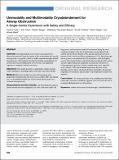| dc.contributor.author | Inaty, Hanine | |
| dc.contributor.author | Folch, Erik E | |
| dc.contributor.author | Berger, Robert | |
| dc.contributor.author | Fernandez-Bussy, Sebastian | |
| dc.contributor.author | Chatterji, Sumit | |
| dc.contributor.author | Alape, Daniel | |
| dc.contributor.author | Majid, Adnan | |
| dc.date.accessioned | 2018-05-25T16:00:43Z | |
| dc.date.issued | 2016 | |
| dc.identifier | Quick submit: 2017-07-17T09:53:20-0400 | |
| dc.identifier.citation | Inaty, Hanine, Erik Folch, Robert Berger, Sebastian Fernandez-Bussy, Sumit Chatterji, Daniel Alape, and Adnan Majid. 2016. “Unimodality and Multimodality Cryodebridement for Airway Obstruction. A Single-Center Experience with Safety and Efficacy.” Annals of the American Thoracic Society 13 (6) (June): 856–861. doi:10.1513/annalsats.201508-486oc. | en_US |
| dc.identifier.issn | 2329-6933 | en_US |
| dc.identifier.uri | http://nrs.harvard.edu/urn-3:HUL.InstRepos:37047506 | |
| dc.description.abstract | Rationale: Cryodebridement (CD) refers to the removal of obstructive material from the lumen of the tracheobronchial tree by freezing with a cryoprobe, which is usually inserted through a flexible bronchoscope. This method of achieving instant recanalization of airways has been established for over 20 years, but published experience comprises limited case series.
Objectives: This study describes a single large-volume referral center experience, including clinical outcomes and safety profile.
Methods: Electronic medical records of 156 patients who underwent bronchoscopic CD between December 2007 and March 2012 as the primary method to relieve airway obstruction were reviewed retrospectively.
Measurements and Main Results: The most frequent cause of airway obstruction was malignancy (n = 88), with non–small-cell lung cancer and metastatic renal cell carcinoma being the most common etiologies. The site of obstruction was localized to the central airways in 63 patients (40%) and the distal airways in 44 patients (28%), and it was diffuse in 49 patients (32%). Bronchoscopic airway patency was achieved in 95% of patients, with the highest success rates found in those with obstruction localized in the central airways. Improvement in symptoms occurred in 118 (82%) of 144 symptomatic patients. Serious complications were reported in 17 patients (11%) and included respiratory distress, severe bleeding, airway injury, and hemodynamic instability. All patients responded to treatment, and no intra- or postoperative deaths were reported.
Conclusions: CD, when used alone or in combination with other endoscopic treatment modalities, appears to be safe and effective in treating endoluminal airway obstruction. | en_US |
| dc.language.iso | en_US | en_US |
| dc.publisher | American Thoracic Society | en_US |
| dc.relation.isversionof | 10.1513/annalsats.201508-486oc | en_US |
| dash.license | LAA | |
| dc.title | Unimodality and Multimodality Cryodebridement for Airway Obstruction. A Single-Center Experience with Safety and Efficacy | en_US |
| dc.type | Journal Article | en_US |
| dc.date.updated | 2017-07-17T13:53:26Z | |
| dc.description.version | Version of Record | en_US |
| dc.relation.journal | Annals of the American Thoracic Society | en_US |
| dash.depositing.author | Folch, Erik E | |
| dc.date.available | 2016 | |
| dc.date.available | 2018-05-25T16:00:43Z | |
| dc.identifier.doi | 10.1513/annalsats.201508-486oc | * |
| dash.contributor.affiliated | Fernandez-Bussy, Sebastian | |
| dash.contributor.affiliated | Folch, Erik | |
| dash.contributor.affiliated | Majid, Adnan | |


